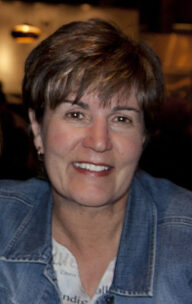By Ryn Clarke
Forced to slow down and stay home during Ohio's COVID-19 stay-at-home order, Ryn Clarke reconnected with photo compositing, a digital technique she had learned but had not fully explored. Incorporating her love of gardening and nature, imaginary ecosystems were soon born, brimming with color, cheer and tranquility. In this post Ryn explains her motivation for the work as well as the artistry behind it. (Note - hover over the images with your mouse to see the titles of the artwork.)
- What was was your inspiration for the composites?
During the pandemic lockdown, I took my three dogs for long walks around the neighborhood and in the woods. It was the only thing I could do outside my house. Simultaneously the weather in Ohio was getting better as spring was approaching. Unlike previous strolls, however, I started really noticing what was around me - the trees were leafing out, the flowers were beginning to bloom and the landscape was turning green. So, with the help of my camera and iPhone, I began to document the arrival of spring.
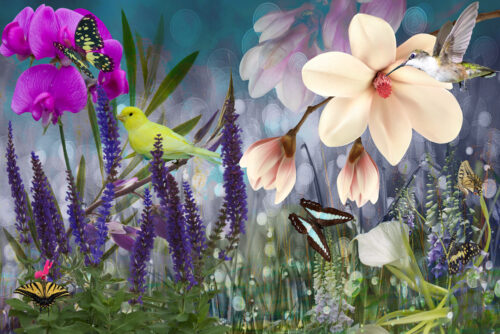
A couple of years ago I took a workshop on composite photography, but I never did anything with it. With everything coming to a screeching halt and spending so much time at home, I decided to play with the composite ability again. The idea of taking the images from my walks and bringing in other images I had taken previously, into a digital collage, began to bubble up in my head.
Additionally, the more I spoke with people the more I felt a sense of sadness, loneliness and isolation out there. What could I do to help? I realized I could create stories with my composites that were colorful and happy, share them on social media and see where they would go. That's how it all started to evolve. I just wanted to make people feel good and put a smile on their face.
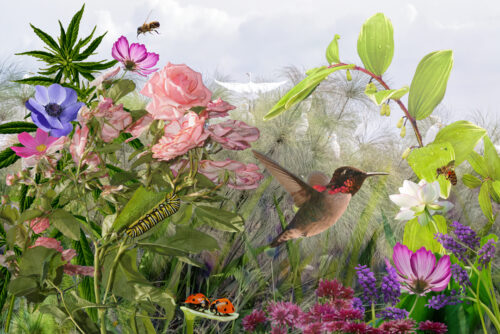
- Where do you start?
When I create a composite I often start with what I see on my walk - a flower, a bird, a branch. I take photos of all kinds of things - dead trees, stumps, rocks - anything that is interesting or that might work as a component. Some of my work originates from travel photos I have taken, like my trip to Africa.
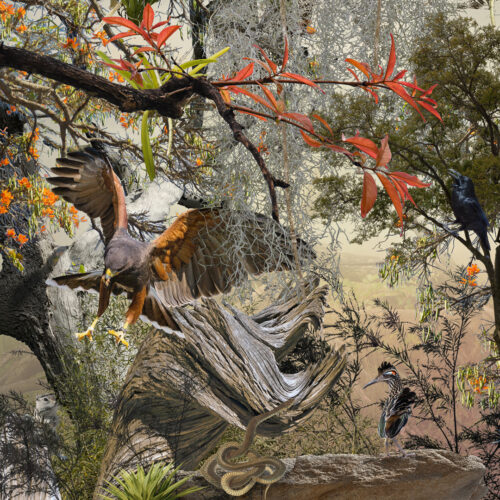
I think about color and how the main subject, such as a bird or bloom, works within the color scheme. I also consider what mood I want to convey - a gentleness or elegance, for example. Many times the idea for the composite comes when I can't sleep at night or when I am alone with my thoughts. When the idea forms I write it down.
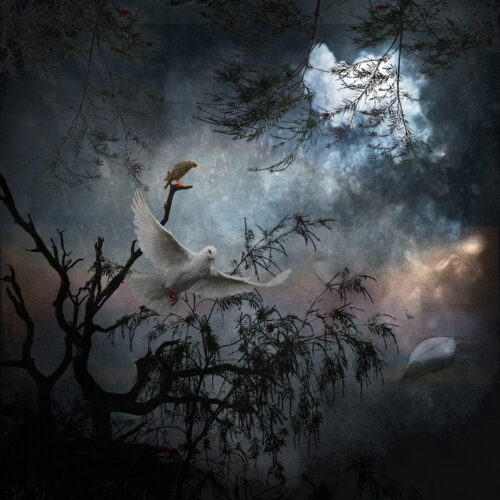
I do quite a bit of research regarding the photos I take, as well as what plant life the birds, butterflies and other pollinators are attracted to. When I take a picture of a tree, flower or bird, I don't always know what species it is. So I try to identify it and then figure out what interacts with it. Even though my composites are part real and part fantasy, there is a relationship between the items I include.
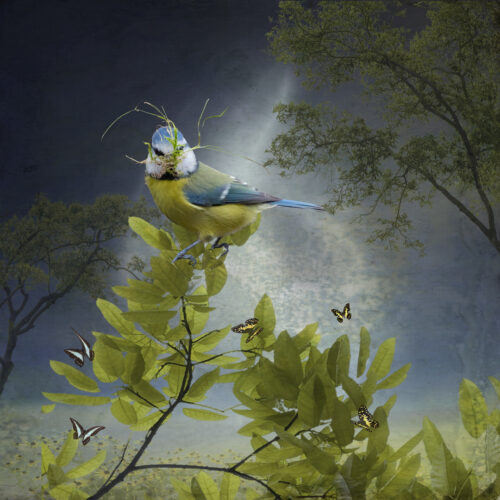
I have an arsenal of landscape and floral photos that I have taken over the years that I can pull from. However, if I don't have a photo of a particular subject, like a hummingbird for example, I look for free images and royalty free stock that I can use. I prefer subject matter with a clean, simple background which makes the masking process much easier. I also have textures that I have purchased.
- What tool(s) do you use?
I use Photoshop to build the layers, and I create layers and layers utilizing different tools. I use Topaz Remask to help with the masking.
Creating a composite is more difficult than one would think. Producing a mask can take up to an hour or more to do - one little mask! After the mask is done, then the work starts. One of the hardest things is building depth. Blurring different parts of the photo makes it more natural - this step is often forgotten. The blur tool creates an ethereal look for me. The blending options are equally important. Then there is the lighting - I try to make sure every element is lighted properly. I add movement with the warping tool.
Here is an example:
Screenshot #1 - I started with a landscape from Africa and some blurred textures. Then I added the bird. The color of the bird was important because I wanted the bird and the background to blend with each other and create a soothing atmosphere.

Screenshot # 2 - I knew I wanted to use the peony as the plant. The peony on the right has already bloomed, but I planned to place other things on top of it. Behind the bird there is a leaf with two blue pushpins. This stem came from a peony in my garden. I brought it inside my studio, pinned it to a white foam core, photographed it, then masked it. I also added a layer of dead branches and a boulder that has been grayed out.

Screenshot # 3 - I covered up the pins with additional foliage. I added the peonies, then created movement by using the warp tool to bend the stems and petals. The smaller pink peony at the bottom brings out the pink in the bird's neck. The dragonfly picks up the blue in the birds wings. The ferns in the background provide depth.

Screenshot # 4 - I added the hummingbird and the bee which are attracted to the peonies. The ant, which encourages the bud to open by crawling on it, is peeking out of the peony on the right. I also added a caterpillar to the bottom stem.

Here is the final image!
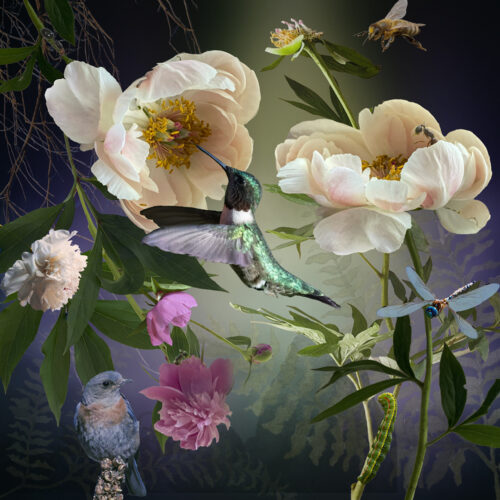
- How much time does it take to create?
It can take anywhere from a couple of hours to a couple of days to finish a composite, depending on what the storyline is. If I am lucky the story and the images become inseparable and they work together. Then I can begin to work with the reality and the make-believe. People say, "Oh, something is different here!" The color and the light give me direction and allow me to create something unworldly.
In the beginning I started doing this daily. A friend of mine asked, "How can you do this every day?" I don't know how, except that this imagery just started to flow out of me. Now with so much in bloom I don't always know where to start. Sometimes I have to step away for a day and regroup.
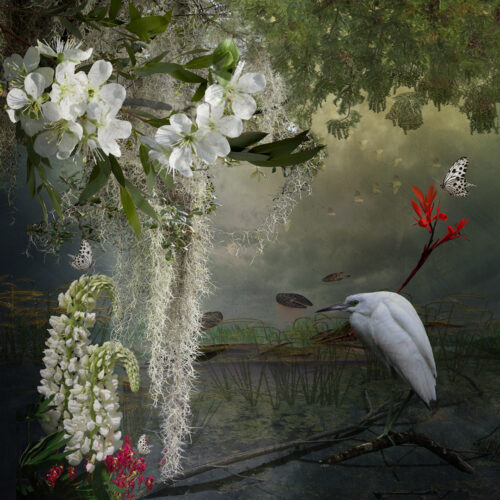
- What tip would you share with aspiring composite artists?
Learn to think out of the box. Don't get stuck trying to meet certain composition guidelines, like the rule of thirds. My favorite quote is by Katharine Hepburn: "If you obey all the rules you miss all the fun." I agree with Katharine. This is fun. And it's okay to break the rules.
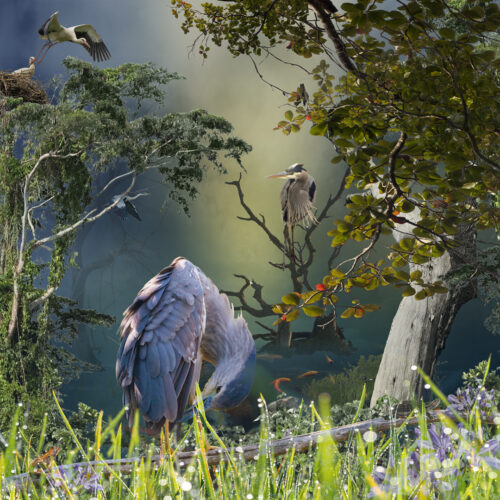
Ryn Clarke is a visual artist, photographer and educator from Cleveland, Ohio. She embraces both her iPhone and digital SLR cameras and considers it a gift to be able to share what she has learned. Besides leading both beginner and intermediate iPhone workshops around the country, Ryn also experiments with different photographic techniques in her image making, including elaborate nature compositing, photopolymer gravure, encaustic and hand-colored photographic prints.
Ryn is presently the Zone X Photography Representative for The Garden Club of America. She is on the board of The Artists Archives of the Western Reserve in Cleveland, Ohio and a past president of the Cleveland Museum of Arts’ affiliate group, Friends of Photography. She holds a fine art degree from Marymount University and has exhibited nationally and internationally. Her work is held by private, corporate and medical collections throughout the United States. To view more of Ryn's work, go to www.rynclarkephotography.com.
